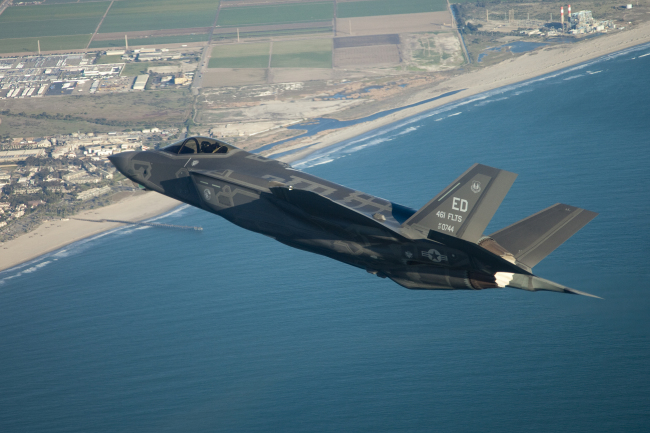EGLIN AIR FORCE BASE, Florida ― The 33rd Fighter Wing at the Eglin Air Force Base is currently the one and only center for training F-35 pilots and maintenance crew.
With an array of high-tech facilities including simulators and life-size mockups, the command featuring the integration of the Marine Corps, Air Force and Navy offers necessary education to transition to the fifth-generation fighter operations.
“The integrated training center is the heart of F-35 training for both pilots and maintainers,” Col. Andrew Toth, the commander of the unit, told the Korean press contingent last week.
With an array of high-tech facilities including simulators and life-size mockups, the command featuring the integration of the Marine Corps, Air Force and Navy offers necessary education to transition to the fifth-generation fighter operations.
“The integrated training center is the heart of F-35 training for both pilots and maintainers,” Col. Andrew Toth, the commander of the unit, told the Korean press contingent last week.

Some $400 million was spent on refurbishing an operational unit for fourth-generation warplanes, such as the F-15C, into a training facility. The base seeks to accommodate up to 2,000 people and run 59 aircraft ― 24 for the Air Force and 35 for the Marine Corps.
The command received its first F-35A in July 2011 and began test-flying it in March last year. It brought in its first marine variants in January 2012 and anticipates the delivery of the naval variant in April this year.
The course at this center takes three months ― six weeks of academic study and simulator-based practice, and six weeks of actual flight. As the center offers training for all variants for the three armed services, it helps enhance each service’s understanding of cultural differences.
Air Force Maj. Matt Johnston, the chief of standardization and evaluations at the base, said given the similarity with the fourth-generation fighters, it was an “easy” transition to the F-35.
“The transition is very easy and it is very similar to the fourth-generation fighters and the panoramic cockpit display makes the interpretation (of the display) very easy,” he told reporters.
Regarding the amount of time it would take to get used to tactical maneuverings, Johnston said the simulator would help as the fighter was still under development.
“It is a growth program, and as years go by, the jet’s capability is growing. When that happens, training will get longer, but we can leverage the simulator to minimize the flight hours we have to put on the F-35,” he said.
As for tactical flight training, students here practice mapping the ground with radar and conducting basic air-to-ground and air-to-air missions with the virtual mobilization of guided missiles such as the Joint Direct Attack Munition, Toth explained.
Toth, who himself is a qualified flight instructor with 40 hours logged in the F-35, said that F-35 training would not be that challenging for seasoned South Korean pilots to become a “wingman.”
“My expectation is the initial cadre of Korean pilots would come here very experienced in other systems too so that they can graduate the program and then move on to be instructors (back home),” he said.
By Song Sang-ho, Korea Herald correspondent
(sshluck@heraldcorp.com)
-
Articles by Korea Herald












![[Today’s K-pop] BTS pop-up event to come to Seoul](http://res.heraldm.com/phpwas/restmb_idxmake.php?idx=644&simg=/content/image/2024/04/17/20240417050734_0.jpg&u=)





![[KH Explains] Hyundai's full hybrid edge to pay off amid slow transition to pure EVs](http://res.heraldm.com/phpwas/restmb_idxmake.php?idx=652&simg=/content/image/2024/04/18/20240418050645_0.jpg&u=20240419100350)

![[Today’s K-pop] Zico drops snippet of collaboration with Jennie](http://res.heraldm.com/phpwas/restmb_idxmake.php?idx=642&simg=/content/image/2024/04/18/20240418050702_0.jpg&u=)